change time GMC YUKON DENALI 2003 Owners Manual
[x] Cancel search | Manufacturer: GMC, Model Year: 2003, Model line: YUKON DENALI, Model: GMC YUKON DENALI 2003Pages: 447, PDF Size: 21.97 MB
Page 3 of 447

Canadian Owners
GENERAL MOTORS, GM, the GM Emblem, GMC, the
GMC Truck Emblem and the name YUKON
DENALINUKON XL DENALI are registered trademarks
of General
Motors Corporation.
This manual includes the latest information at the time it
was printed. We reserve the right
to make changes
after that time without further notice. For vehicles first
sold in Canada, substitute the name “General Motors of
Canada Limited” for GMC whenever it appears in this
manual.
Please keep this manual in your vehicle,
so it will be
there
if you ever need it when you’re on the road. If you
sell the vehicle, please leave this manual in it
so the
new owner can use it.
ii
L.itho in U.S.A.
Part No. S2316 A First Edition
You can obtain a French copy of this manual from your
dealer or from:
Helm, Incorporated
P.O. Box 07130
Detroit, MI 48207
How to Use This Manual
Many people read their owner’s manual from beginning
to end when they first receive their new vehicle.
If
you do this, it will help you learn about the features and
controls for your vehicle. In this manual, you’ll find
that pictures and words work together to explain things.
Index
A good place to look for what you need is the Index in
back of the manual.
It’s an alphabetical list of what’s
in the manual, and the page number where you’ll find it.
@Copyright General Motors Corporation
6/24/02
All Rights Reserved
Page 101 of 447
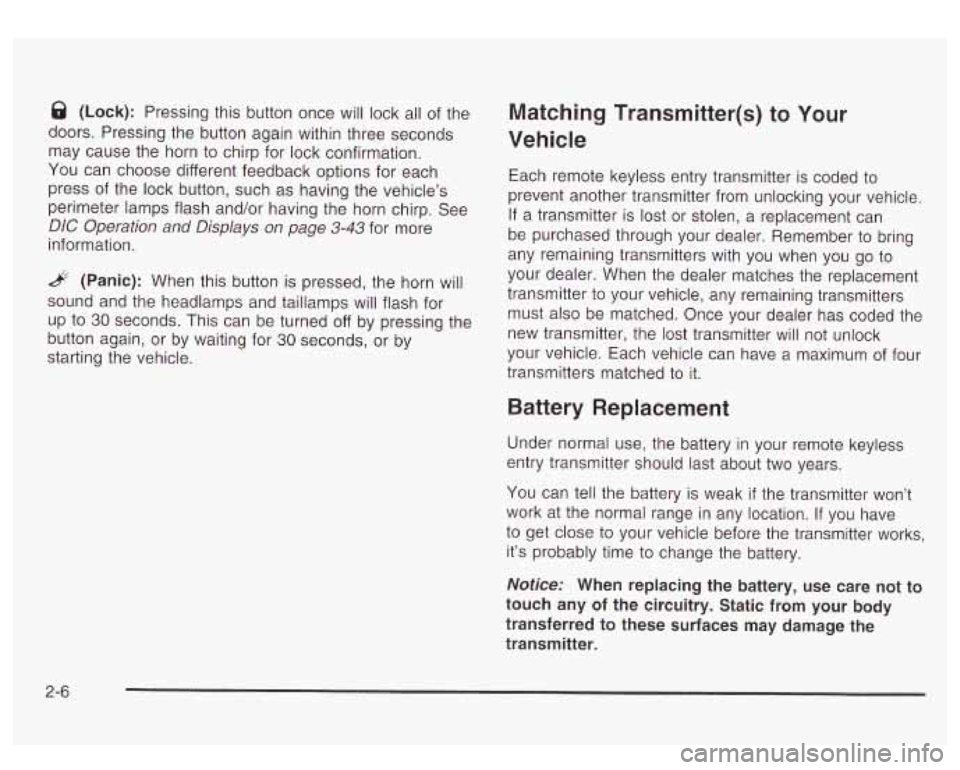
8 (Lock): Pressing this button once will lock all of the
doors. Pressing the button again within three seconds
may cause the horn
to chirp for lock confirmation.
You can choose different feedback options for each
press of the lock button, such as having the vehicle’s
perimeter lamps flash and/or having the horn chirp. See
DIC Operation and Displays on page 3-43 for more
information.
& (Panic): When this button is pressed, the horn will
sound and the headlamps and taillamps will flash for
up
to 30 seconds. This can be turned off by pressing the
button again, or by waiting for
30 seconds, or by
starting the vehicle.
Matching Transmitter(s) to Your
Vehicle
Each remote keyless entry transmitter is coded to
prevent another transmitter from unlocking your vehicle.
If a transmitter is
lost or stolen, a replacement can
be purchased through your dealer. Remember
to bring
any remaining transmitters with you when you go
to
your dealer. When the dealer matches the replacement
transmitter
to your vehicle, any remaining transmitters
must also be matched. Once your dealer has coded the
new transmitter, the
lost transmitter will not unlock
your vehicle. Each vehicle can have a maximum of four
transmitters matched
to it.
Battery Replacement
Under normal use, the battery in your remote keyless
entry transmitter should last about two years.
You can tell the battery is weak
if the transmitter won’t
work at the normal range in any location. If you have
to get close to your vehicle before the transmitter works,
it’s probably time
to change the battery.
Notice: When replacing the battery, use care not to
touch any of the circuitry. Static from your body
transferred to these surfaces may damage the
transmitter.
2-6
Page 115 of 447
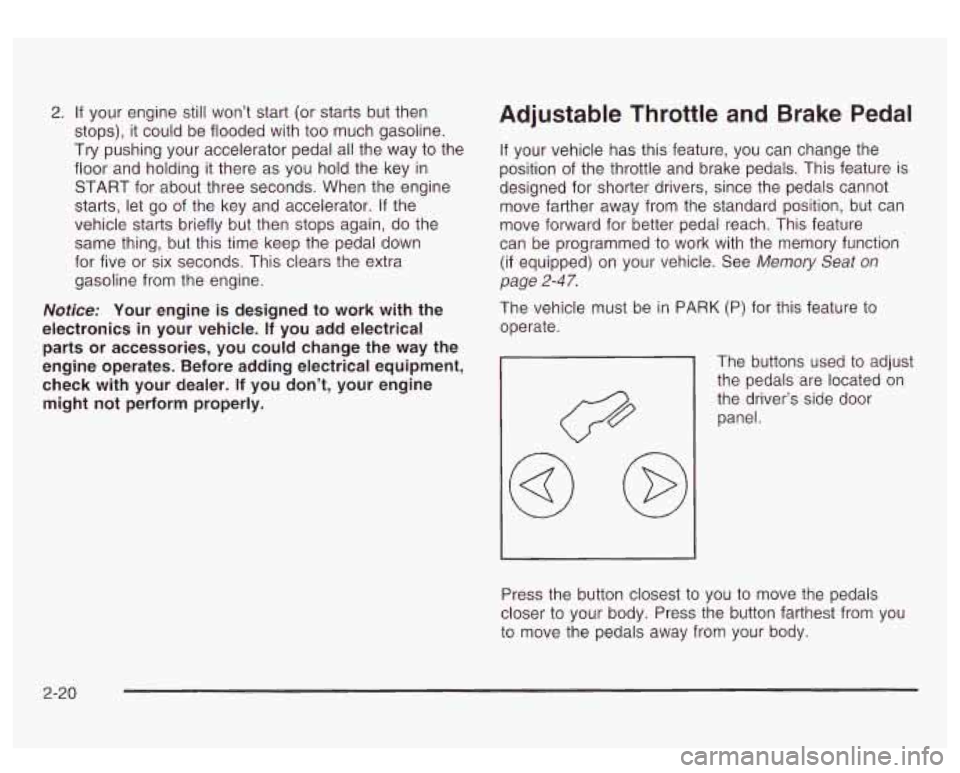
2. If your engine still won’t start (or starts but then
stops), it could be flooded with too much gasoline.
Try pushing your accelerator pedal all the way to the
floor and holding it there as you hold the key in START for about three seconds. When the engine
starts, let go of the key and accelerator. If the
vehicle starts briefly but then stops again, do the
same thing, but this time keep the pedal down
for five or six seconds. This clears the extra
gasoline from the engine.
Notice: Your engine is designed to work with the
electronics in your vehicle.
If you add electrical
parts or accessories, you could change the way the
engine operates. Before adding electrical equipment,
check with your dealer. If you don’t, your engine
might not perform properly.
Adjustable Throttle and Brake Pedal
If your vehicle has this feature, you can change the
position of the throttle and brake pedals. This feature is
designed for shorter drivers, since the pedals cannot
move farther away from the standard position, but can
move forward for better pedal reach. This feature
can be programmed to work with the memory function
(if equipped) on your vehicle. See Memory Seat on
page 2-47.
The vehicle must be in PARK (P) for this feature to
operate.
The buttons used to adjust
the pedals are located on
the driver’s side door panel.
Press the button closest to you to move the pedals
closer to your body. Press the button farthest from you
to move the pedals away from your body.
2-20
Page 126 of 447
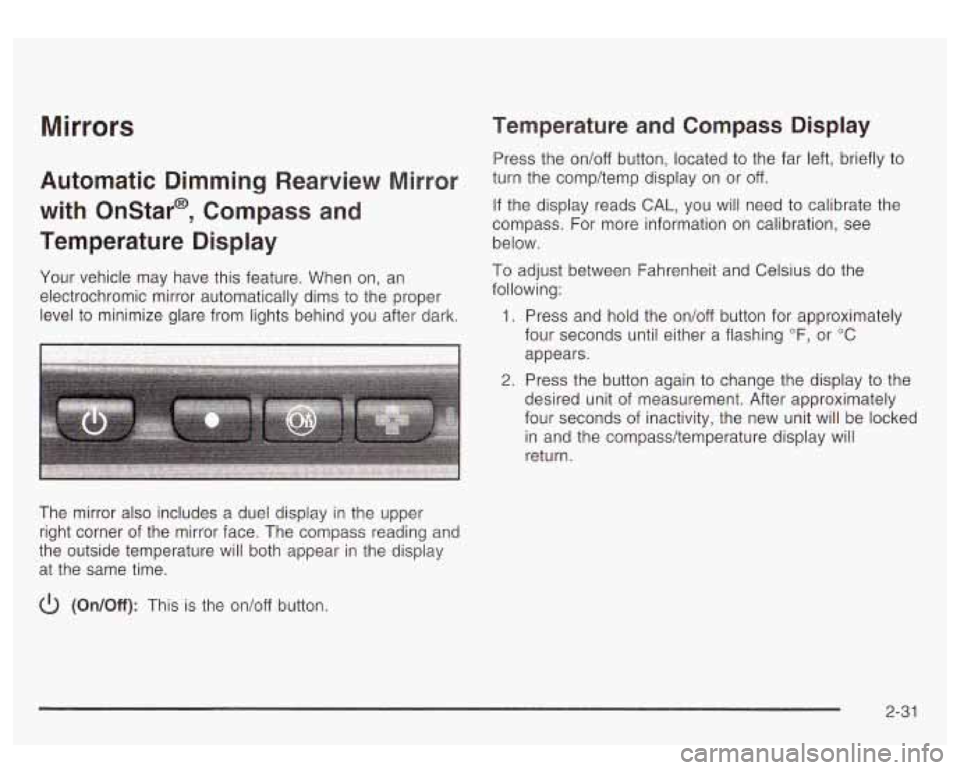
Mirrors
Automatic Dimming Rearview Mirror
with Onstar@, Compass
and
Temperature Display
Your vehicle may have this feature. When on, an
electrochromic mirror automatically dims to the proper
level to minimize glare from lights behind you after dark.
The mirror also includes a duel display in the upper
right corner of the mirror face. The compass reading and
the outside temperature will both appear in the display
at the same time.
Temperature and Compass Display
Press the on/off button, located to the far left, briefly to
turn the comp/temp display on or
off.
If the display reads CAL, you will need to calibrate the
compass. For more information on calibration, see
below.
To adjust between Fahrenheit and Celsius do the
following:
1.
2. Press and hold the
on/off button for approximately
four seconds until either a flashing OF, or "C
appears.
Press the button again to change the display to the
desired unit
of measurement. After approximately
four seconds of inactivity, the new unit will be locked
in and the compass/temperature display will
return.
6 (On/Off): This is the on/off button.
2-31
Page 145 of 447
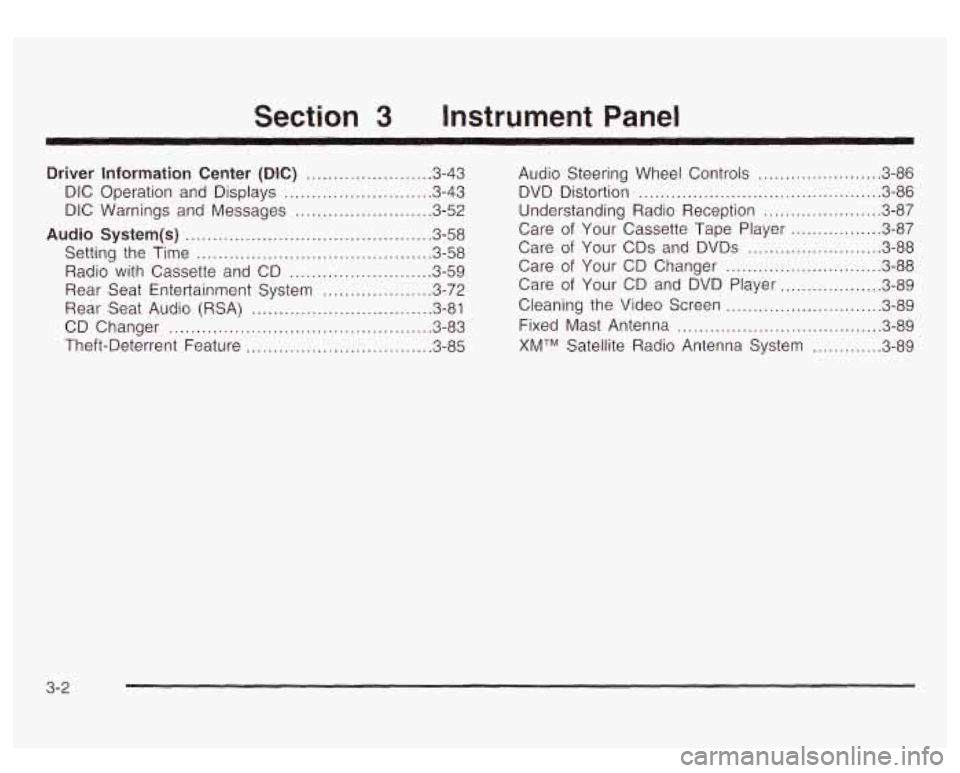
Section 3 Instrument Panel
Driver Information Center (DIC) ................... 3.43
DIC Operation and Displays
....................... 3.43
DIC Warnings and Messages
..................... 3.52
Audio
System(s) ............................................. 3.58
Setting the Time
........................................... 3.58
Radio with Cassette and CD
.......................... 3-59
Rear Seat Entertainment System
.................... 3-72
Rear Seat Audio (RSA)
................................. 3.81
CD Changer
................................................ 3.83
Theft-Deterrent Feature
.................................. 3-85
~ ~~ ~~~
Audio Steering Wheel Controls ........ ....... 3.86
DVD Distortion
............................................. 3.86
Understanding Radio Reception
...................... 3.87
Care
of Your CDs and DVDs ......................... 3-88
Care
of Your
Cassette Tape Player ................. 3-87
Care
of Your CD Changer ............................. 3-88
Care
of Your CD and DVD Player ................... 3-89
Cleaning the Video Screen
............................. 3-89
Fixed Mast Antenna
.................................. 3-89
XMTM Satellite Radio Antenna System ......... 3-89
3-2
Page 151 of 447
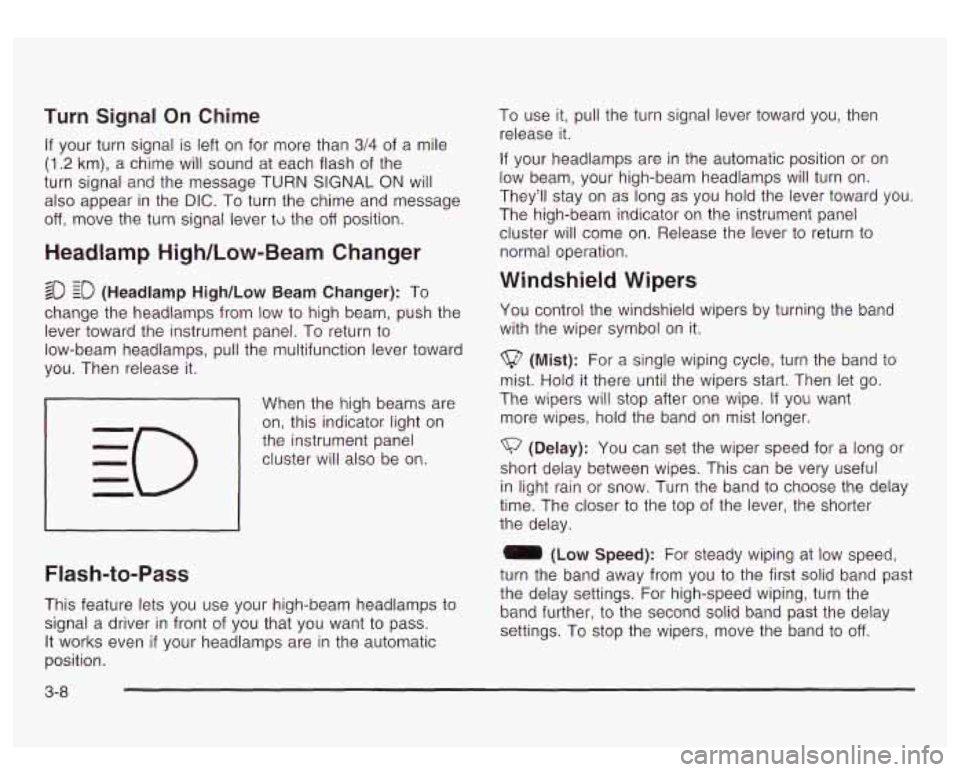
Turn Signal On Chime
If your turn signal is left on for more than 3/4 of a mile
(1.2 km), a chime will sound at each flash of the
turn signal and the message TURN SIGNAL ON will
also appear in the
DIC. To turn the chime and message
off, move the turn signal lever td the off position.
Headlamp High/Low-Beam Changer
$0 io (Headlamp High/Low Beam Changer): To
change the headlamps from low
to high beam, push the
lever toward the instrument panel. To return
to
low-beam headlamps, pull the multifunction lever toward
you. Then release
it.
When the high beams are
on, this indicator light on
the instrument panel
cluster will also be on.
I I
Flash-to-Pass
This feature lets you use your high-beam headlamps to
signal a driver in front of you that you want to pass.
It works even if your headlamps are in the automatic
position. To
use it, pull the turn signal lever toward you, then
release it.
If your headlamps are in the automatic position or on
low beam, your high-beam headlamps will turn on.
They’ll stay on
as long as you hold the lever toward you.
The high-beam indicator
on the instrument panel
cluster will come on. Release the lever
to return to
normal operation.
Windshield Wipers
You control the windshield wipers by turning the band
with the wiper symbol on it.
(Mist): For a single wiping cycle, turn the band to
mist. Hold it there until the wipers start. Then let go.
The wipers will stop after one wipe.
If you want
more wipes, hold the band on mist longer.
(Delay): You can set the wiper speed for a long or
short delay between wipes. This can be very useful
in light rain or snow. Turn the band to choose the delay
time. The closer
to the top of the lever, the shorter
the delay.
0 (Low Speed): For steady wiping at low speed,
turn the band away from you
to the first solid band past
the delay settings. For high-speed wiping, turn the
band further, to the second solid band past the delay
settings. To stop the wipers, move the band
to off.
3-8
Page 156 of 447

Exterior Lamps
The control on the driver’s side of your instrument panel
operates the exterior lamps.
The exterior lamp control has four positions:
AUTO: Turn the control to this position to put the
system into automatic headlamp mode. The Daytime
Running Lamps (DRL) will also be activated
if it is light
enough outside.
A light near the symbol will be lit
when in this mode.
0 (Off): Turn the control to this position and release it
to turn
off all exterior lamps including the DRLs. A
light near the symbol will be lit when in this mode.
To turn the lamps back on when in this mode, turn the
switch to the headlamp mode. The
off mode will
cancel when the vehicle is turned
off. This mode is not
available for vehicles first sold in Canada.
:oo: (Parking Lamps): Turn the control to this position
to turn on the parking lamps, together with the
following:
Parking Lamps
Sidemarker Lamps
Taillamps
License Plate Lamps
Instrument Panel Lights
$0 (Headlamps): Turn the control to this position to
turn
on the headlamps, together with the previously
listed lamps and lights.
When the vehicle is turned
off and the headlamps are in
AUTO, the headlamps may automatically remain on
for a set time. You can change this delay time using the
DIC. See Driver hformation Center
(DIC) on page 3-43.
You can switch your headlamps from low to high-beam
by pushing the turn signaVmultifunction lever toward
the instrument panel.
3-1 3
Page 157 of 447
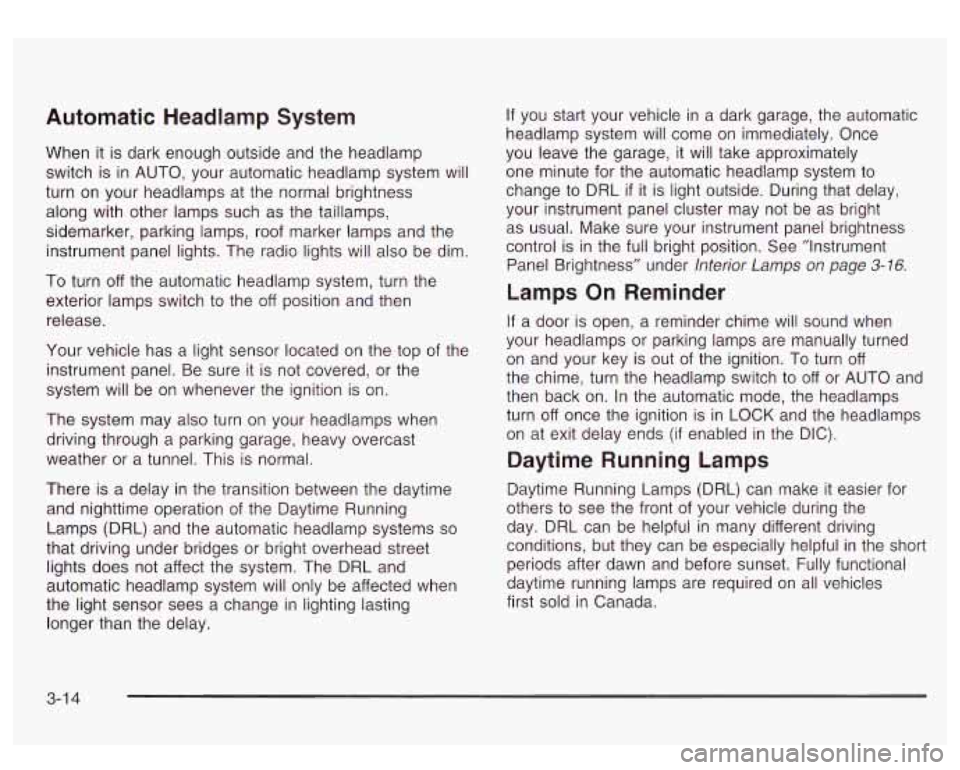
Automatic Headlamp System
When it is dark enough outside and the headlamp
switch is in AUTO, your automatic headlamp system will
turn on your headlamps at the normal brightness
along with other lamps such as the taillamps,
sidemarker, parking lamps, roof marker lamps and the
instrument panel lights. The radio lights will also be dim.
To turn off the automatic headlamp system, turn the
exterior lamps switch
to the off position and then
release.
Your vehicle has a light sensor located on the top of the
instrument panel. Be sure
it is not covered, or the
system will be on whenever the ignition is on.
The system may also turn on your headlamps when
driving through a parking garage, heavy overcast
weather or a tunnel. This is normal.
There is a delay in the transition between the daytime
and nighttime operation of the Daytime Running
Lamps (DRL) and the automatic headlamp systems
so
that driving under bridges or bright overhead street
lights does not affect the system. The DRL and
automatic headlamp system will only be affected when
the light sensor sees a change in lighting lasting
longer than the delay. If
you start your vehicle in a dark garage, the automatic
headlamp system will come on immediately. Once
you leave the garage,
it will take approximately
one minute for the automatic headlamp system to
change
to DRL if it is light outside. During that delay,
your instrument panel cluster may not be as bright
as usual. Make sure your instrument panel brightness
control is in the full bright position. See ”Instrument
Panel Brightness” under lnterior
Lamps on page 3-76.
Lamps On Reminder
If a door is open, a reminder chime will sound when
your headlamps or parking lamps are manually turned
on and your key is out of the ignition. To turn off
the chime, turn the headlamp switch
to off or AUTO and
then back on. In the automatic mode, the headlamps
turn off once the ignition is in LOCK and the headlamps
on at exit delay ends
(if enabled in the DIC).
Daytime Running Lamps
Daytime Running Lamps (DRL) can make it easier for
others
to see the front of your vehicle during the
day. DRL can be helpful in many different driving
conditions, but they can be especially helpful in the short
periods after dawn and before sunset. Fully functional
daytime running lamps are required on all vehicles
first sold in Canada.
3-1 4
Page 165 of 447
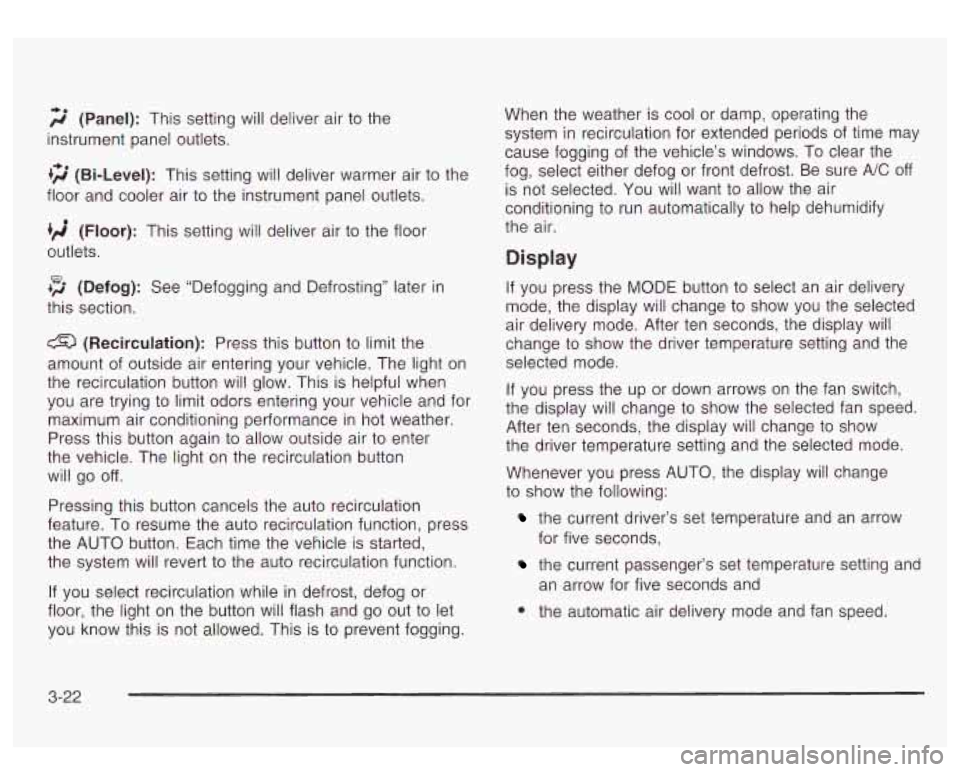
2 (Panel): This setting will deliver air to the
instrument panel outlets.
+2 (Bi-Level): This setting will deliver warmer air to the
floor and cooler air
to the instrument panel outlets.
(Floor): This setting will deliver air to the floor
outlets.
+3 (Defog): See “Defogging and Defrosting” later in
this section.
(Recirculation): Press this button to limit the
amount of outside air entering your vehicle. The light on
the recirculation button will glow. This is helpful when
you are trying
to limit odors entering your vehicle and for
maximum air conditioning performance in hot weather.
Press this button again to allow outside air to enter
the vehicle. The light on the recirculation button
will go
off.
Pressing this button cancels the auto recirculation
feature.
To resume the auto recirculation function, press
the AUTO button. Each time the vehicle is started,
the system will revert
to the auto recirculation function.
If you select recirculation while in defrost, defog or
floor, the light on the button will flash and go out
to let
you know this is not allowed. This is
to prevent fogging. When
the weather is cool or damp, operating the
system in recirculation for extended periods of time may
cause fogging of the vehicle’s windows.
To clear the
fog, select either defog or front defrost. Be sure
A/C off
is not selected. You will want to allow the air
conditioning
to run automatically to help dehumidify
the air.
Display
If you press the MODE button to select an air delivery
mode, the display will change to show you the selected
air delivery mode. After ten seconds, the display will
change to show the driver temperature setting and the
selected mode.
If you press the up or down arrows on the fan switch,
the display will change to show the selected fan speed.
After ten seconds, the display will change
to show
the driver temperature setting and the selected mode.
Whenever you press AUTO, the display will change
to show the following:
the current driver’s set temperature and an arrow
for five seconds,
the current passenger’s set temperature setting and
an arrow for five seconds and
0 the automatic air delivery mode and fan speed.
3-22
Page 166 of 447

If the driver’s and passenger’s temperature settings are
the same when AUTO
is pressed, the temperature
setting and both arrows will be displayed for five
seconds along with the automatic air delivery mode and
fan speed. After the five second update, the display
will change to show the temperature setting, both arrows
and AUTO.
Air Conditioning
a (Air Conditioning): Press this button to turn the air
conditioning compressor on and
off.
% (Air Conditioning Off): When you turn the air
conditioning
off, this symbol will appear on the display.
When air conditioning is selected or in AUTO mode,
the system will run the air conditioning automatically to
cool and dehumidify the air entering the vehicle.
If
you select A/C off while in front defrost or defog, the
A/C off symbol will flash to let you know this is not
allowed. This is
to prevent fogging.
On hot days, open the windows long enough to let hot
inside air escape. This reduces the time it takes for
your vehicle to cool down. Then keep your windows
closed for the air conditioner to work its best. On
cool, but sunny days while using manual operation
of the automatic system, use bi-level
to deliver warm
air to the floor and cooler air to the instrument
panel outlets. To warm or cool the air delivered, turn the
temperature knob to the desired setting.
In AUTO mode the system will cool and dehumidify the
air inside the vehicle. Also while in AUTO mode, the
system will maximize its performance by using
recirculation as necessary.
Heating
On cold days when using manual operation of the
automatic system, choose floor mode to deliver air to
the floor outlets. To warm or cool the air delivered, turn
the temperature knob to the desired setting.
If you want to use the automatic mode, press
AUTO and adjust the temperature by turning the
temperature knob.
The heater works best
if you keep the windows closed
while using it.
3-23